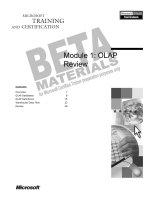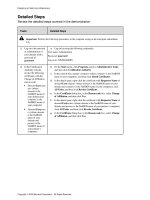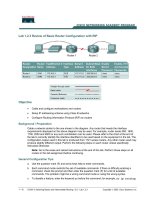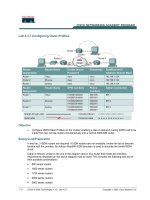KBS-Review
Bạn đang xem bản rút gọn của tài liệu. Xem và tải ngay bản đầy đủ của tài liệu tại đây (571.73 KB, 104 trang )
COURSE REVIEW
INTRODUCTION TO
KNOWLEDGE ENGINEERING
Sistem Berbasis Pengetahuan
Agenda
What is knowledge?
Types of knowledge
Knowledge engineering
Knowledge engineers
2
Philosophical Basis
Traditional questions that have been analyzed by
philosophers, psychologists, and linguist:
What is knowledge?
What do people have inside their head when they know
something?
Is knowledge expressed in words?
If so, how could one know things that are easier to do than to say,
like tying a shoestring or hitting a baseball?
If knowledge is not expressed in words, how can it be transmitted
in language?
How is knowledge related to the world?
What are the relationships between the external world,
knowledge in the head, and the language used to express
knowledge about the world?
3
Philosophical Basis
With the advent of computers, the questions
addressed by the field of artificial intelligence (AI)
are:
Can knowledge be programmed in a digital computer?
Can computers encode and decode that knowledge in
ordinary language?
Can they use it to interact with people and with other
computer systems in a more flexible or helpful way?
4
Information Processing Views of
Knowledge
Hierarchical view: data information knowledge
Information is the input or raw material of new knowledge
Knowledge is authenticated/personalized information
Reversed hierarchical view: knowledge information data
Knowledge must exist before information can be formulated and before data
can be collected
Non-hierarchical view: data information
Knowledge is needed in converting data into information
Knowledge is the accumulation of experiences vs. knowledge is created through
conjectures and refutations.
Knowledge
5
Alternative Perspectives on Knowledge
Knowledge can be defined as a justified belief that
increases an entity’s capacity for effective action.
It may be viewed from several perspectives:
(1) a state of mind – knowledge is the state of knowing and
understanding
(2) an object – knowledge is an object to be stored and
manipulated
(3) a process – knowledge is a process of applying expertise
(4) a condition – knowledge is organized access to and
retrieval of content
(5) a capability – knowledge is the potential to influence
action
6
Taxonomies of Knowledge
Tacit vs. explicit
Explicit knowledge refers to knowledge that is transmittable
in formal, systematic language
Tacit knowledge is deeply rooted in actions, experience, and
involvement in a specific context. It consists of cognitive
element (mental models) and technical element (know-how
and skills applicable to specific work).
Individual vs. social
Individual knowledge is created by and exists in the
individual whereas social knowledge is created by and
exists in the collective actions of a group.
7
Taxonomies of Knowledge
Five Types of Knowledge
Declarative knowledge
Know-about
Procedural knowledge
Know-how
Causal knowledge
Know-why
Conditional knowledge
Know-when
Relational knowledge
Know-with
Meta-knowledge
Knowledge about knowledge
8
Four Modes of Knowledge Conversion
(Nonaka 1994)
Socialization Externalization
Internalization Combination
Tacit knowledge Explicit knowledge
Tacit
knowledge
Explicit
knowledge
From
To
9
Knowledge Engineering
An engineering discipline that involves integrating
knowledge into computer systems in order to solve
complex problems normally requiring a high level
of human expertise (Feigenbaum and Pamela,
1983)
It normally involves five distinct steps in transferring
human knowledge into some form of knowledge
based systems (KBS)
10
Five Steps of Knowledge Engineering
Knowledge acquisition
Knowledge validation
Knowledge representation
Inferencing
Explanation and justification
11
Two Main Views of Knowledge
Engineering
Transfer view – This is the traditional view. In this
view, the key idea is to apply conventional
knowledge engineering techniques to transfer
human knowledge into the computerized system.
Modeling view – In this view, the knowledge
engineer attempts to model the knowledge and
problem solving techniques of the domain expert
into the computerized system.
12
Knowledge Engineering (KE) vs.
Knowledge Management (KM)
KE is primarily concerned with constructing a
knowledge-bases system while KM is primarily
concerned with identifying and leveraging
knowledge to the organization’s benefit.
KE and KM activities are inherently interrelated.
Knowledge engineers are interested in what
technologies are needed to meet the enterprise’s
KM needs.
13
Knowledge Engineers
A knowledge engineer is responsible for obtaining knowledge from human
experts and then entering this knowledge into some form of KBS.
In developing KBS, the knowledge engineer must apply methods, use tools,
apply quality control and standards, plan and manage projects, and take
into account human, financial, and environmental constraints.
Required skills of a knowledge engineer
Knowledge representation
Fact finding (knowledge elicitation)
Human skills
Visualization skills
Analysis
Creativity
Managerial
14
COURSE REVIEW
KNOWLEDGE-BASED
SYSTEMS
Sistem Berbasis Pengetahuan
Agenda
Expert systems
Neural networks
Case-based reasoning
Genetic algorithms
Intelligent agents
16
What are KBSs?
A knowledge based system is a system that uses
artificial intelligence techniques in problem-solving
processes to support human decision-making, learning,
and action.
Two central components of KBSs are
Knowledge base
Consists of a set of facts and a set of rules, frames, or procedures
Inference engine
Responsible for the application of knowledge base to the problem on hand.
There are pros and cons of using KBSs, compared to
human expertise.
17
Types of KBSs
Expert systems
Neural networks
Case-based reasoning
Genetic algorithms
Intelligent agents
18
Expert Systems
An expert system is a computer program designed
to emulate the problem-solving behavior of an
expert in a specific domain of knowledge
In order to qualify as an expert system, a system
must have the capability of explaining or justifying
its conclusions.
A system which can explain its reasoning process is
said to demonstrate meta-knowledge (knowledge
about its own knowledge).
19
Features of Problem Solvers
Human experts exhibit certain characteristics and
techniques which help them perform at a high level
in solving problems in their domain:
Solve the problem
Explain the result
Learn
Restructure knowledge
Break rules
Determine relevance
Degrade gracefully
20
Characteristics of Expert Systems
The system performs at a level generally
recognized as equivalent to that of a human expert
or specialist in the field.
The system is highly domain specific.
The system can explain its reasoning.
If the information with which it is working is
probabilistic or fuzzy, the system can correctly
propagate uncertainties and provide a range of
alternative solutions with associated likelihoods.
21
Applications of Expert Systems
DENDRAL
Applied knowledge (i.e., rule-based reasoning)
Deduced likely molecular structure of compounds
MYCIN
A rule-based expert system
Used for diagnosing and treating bacterial infections
XCON
A rule-based expert system
Used to determine the optimal information systems
configuration
New applications: Credit analysis, Marketing, Finance,
Manufacturing, Human resources, Science and
Engineering, Education, …
22
Components of Expert Systems
Knowledge base
Consists of facts and rules
Rules are commonly expressed in if-then structure (production rules)
If-premise then conclusion
If-condition then action
Inference engine
Responsible for rule interpretation and scheduling
Forward chaining vs. backward chaining
User interface
Working memory
Explanation facility
23
Conceptual Architecture of a
Typical Expert Systems
Modeling of Manufacturing Syst ems
Abstract
ajshjaskahskaskjhakjshakhska akjsja s
askjaskjakskjas
Knowledge
Engineer
Knowledge
Base(s)
Inference
Engine
Expert(s)
Printed Materials
User
Interface
Working
Memory
External
Interfaces
Solutions
Updates
Questions/
Answers
Structured
Knowledge
Control
Structure
Expertise
Information
Base Model
Data Bases
Spreadsheets
Knowledge
24
Expert System Building Tools
Programming language
An expert system can be implemented using a general
purpose programming language. However, the
programming language LISP and PROLOG are typically
used in expert systems implementation, in particular
Artificial intelligence applications.
Shells
A shell consists mainly of an inference engine and an editor
to assist developers in building their knowledge base.
Example: CLIPS is an expert system shell developed by
NASA
25









